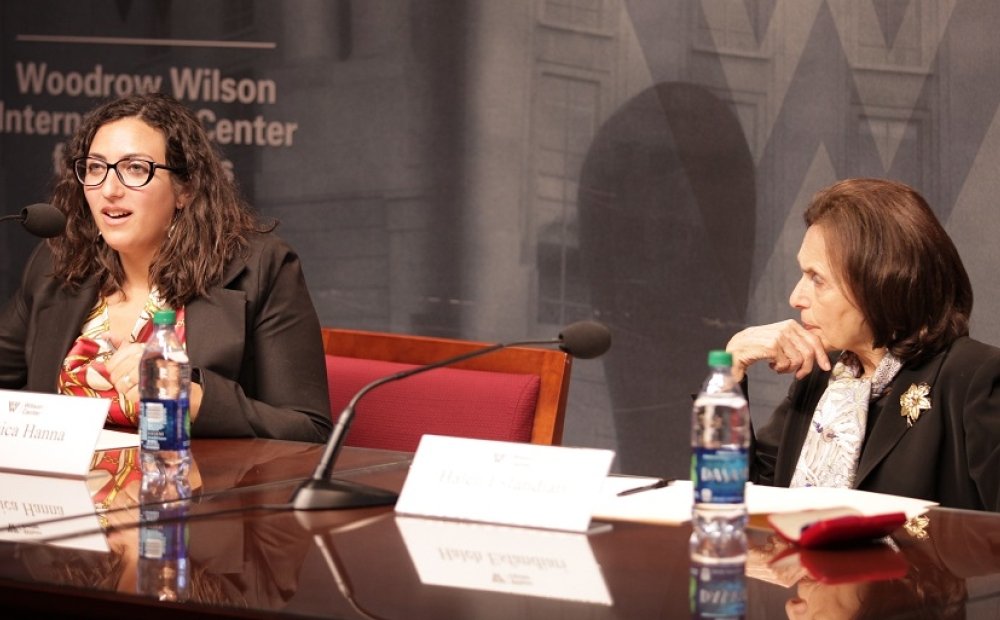The Arab Spring and the State of Egypt’s Antiquities

Egyptologist and SAFE Beacon Award Winner Monica Hanna discussed the impact of the current instability in Egypt on the desecration and looting of archaeological sites and artifacts.
On April 14, 2014, Middle East Program held a meeting, “The Arab Spring and the State of Egypt’s Antiquities” with Hanna, who is also a social media activist. Haleh Esfandiari, Director of the Middle East Program at the Wilson Center, moderated the event.
Hanna began with an overview of various archaeological sites in Egypt that are vulnerable to land-grabbing and looting. She noted that ancient Heliopolis, a very important historical and cultural site, currently lies within the urban fabric of Cairo. Urban expansion surrounds the ancient ruins, and there are ongoing attempts to start construction projects on the site. Additionally, Hanna referred to the Abu Sir site, near the Giza pyramids, which suffers from ongoing looting despite the construction of a wall. In the governorate of Beni Suef, south of Cairo, Hanna described the Abu Malek site as resembling “Swiss cheese” as a result of the many pits that have been dug and used to smuggle ancient relics. In addition to the theft of artifacts, Hanna also pointed to the problems of littering and accumulation of waste near Egypt’s archaeological sites.
In several cities across Egypt, Hanna asserted that there is a calculated process by land-grabbers to gradually integrate archaeological sites into the urban landscape. In many cases, cemeteries are built on these ancient sites, which are impossible to move because they are considered sacred places. Other times, land-grabbers quietly turn the sites into soccer fields or parking lots, changing the community’s collective memory of the site. Hanna described two types of looters: local villagers and organized criminals with access to sophisticated equipment and archaeological information. Hanna said these organized “land mafias” are often linked to international networks of drug and weapons smuggling.
Hanna emphasized that her activism extends beyond ancient Egyptian antiquities to the protection of Islamic and Christian historical sites. She referred to the Coptic monastery at Ansina that has recently been the target of significant looting. The looters used bulldozers and explosives to rapidly destroy important parts of the site to find artifacts. Hanna indicated that the desecration of ancient Christian sites may lead to a rise in sectarian tensions. Furthermore, she discussed future construction projects occurring in the Al-Fustat area in Cairo, home of the oldest Islamic center in the country. The governor of Cairo intends to turn the site into a garden and effectively diminish its archaeological significance.
Hanna then described the government’s complicated relationship with the protection of antiquities. The Mubarak regime, she asserted, was involved in antiquity theft. Prior to the revolution, however, Hanna stated that archaeological sites were under better protection, and Egypt’s police force and security apparatus were much more effective. When describing the looting of the Malawi Museum in El-Minya governorate, Hanna indicated that many of the looters were children and were destroying the artifacts to express their opposition to the government. During this incident, several mummies were burned, pottery was destroyed, and stone sarcophagi were broken, among other things.
Finally, Hanna concluded her talk by discussing various ways to better protect archaeological sites in Egypt. First, she suggested improving educational resources and programs for Egyptian youth to teach them about their heritage and how to care for ancient sites. Hanna noted the success of community development projects to involve children in archaeological excavations. Second, she stressed the importance of academic support to document archeological sites and to publish academic reports on the subject. Furthermore, Hanna argued that the Egyptian government should offer more employment opportunities in excavation and archaeological fieldwork. Most of her work, she said, is voluntary. Most importantly, Hanna emphasized the crucial role of awareness campaigns and the use of the media to inform Egyptians about this issue.
By Yomna Sarhan, Middle East Program
Speaker
Hosted By

Middle East Program
The Wilson Center’s Middle East Program serves as a crucial resource for the policymaking community and beyond, providing analyses and research that helps inform US foreign policymaking, stimulates public debate, and expands knowledge about issues in the wider Middle East and North Africa (MENA) region. Read more
